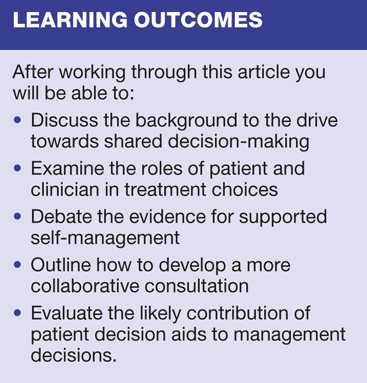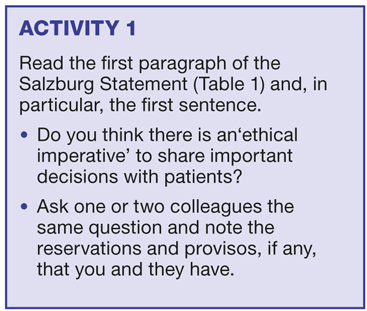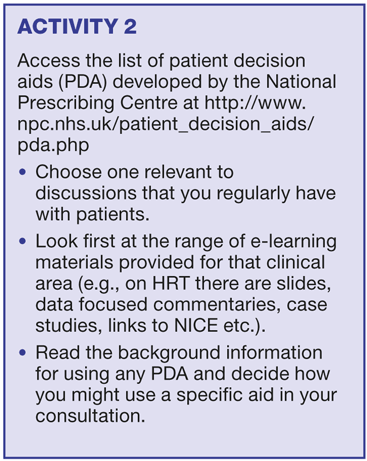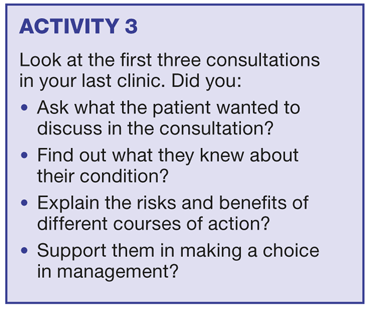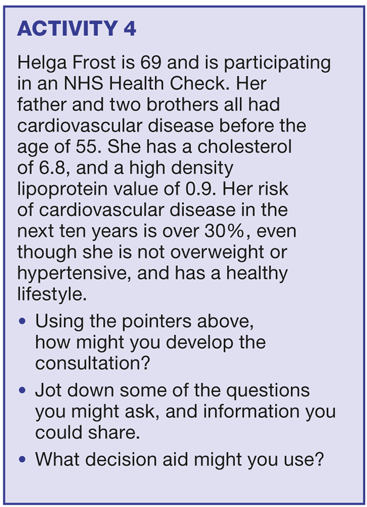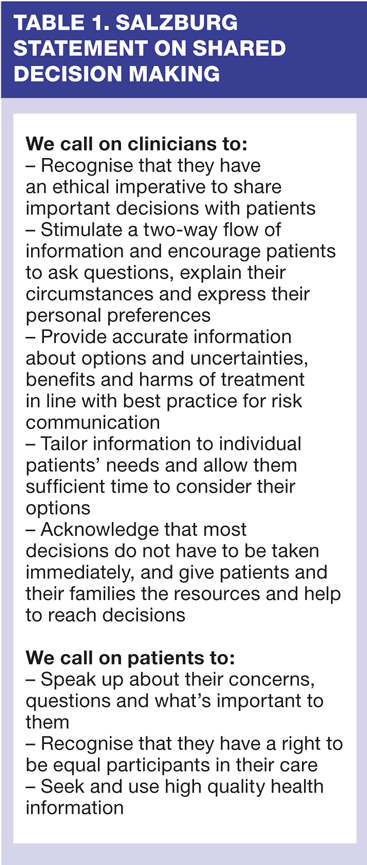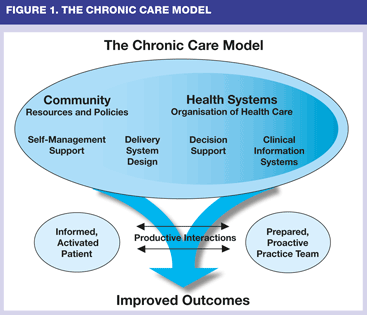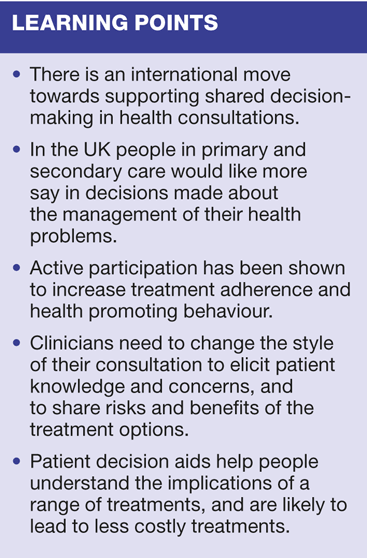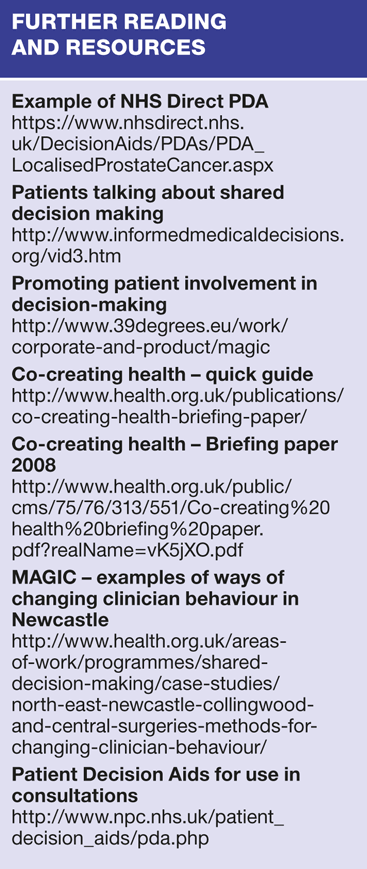Shared decision-making: what's new, and why is it so important?
Liz Bryant
Liz Bryant
RGN
BSc Health Sciences(Nurse Practitioner), Masters inMedical EducationNurse Practitioner, Gateshead; Regional Trainer, Education for Health
The Salzburg statement calls for patients and clinicians to be 'co-producers of health'. For this to become a reality clinical relationships and consultations need to change so that information is shared between patient and clinician, and treatment and management decisions are made together.
What might you identify as the greatest untapped resource in healthcare? The patient? At a seminar in Salzburg in 2010, a gathering of 58 people from 18 countries called for patients and clinicians to work together to be 'co-producers of health'.1 The statement that evolved at that seminar (Table 1)1 spells it out: the patient makes the decisions about their healthcare in partnership with the clinician.
The clinical consultation should be a sharing of information, including patient preferences, up-to-date evidence and discussion of risk, so that treatment and management decisions are made together. Policy makers and researchers have linked responsibilities in order to facilitate this revolution in the clinical relationship and the promotion of shared decision-making.
POLICY LEADS
The Salzburg Seminar was not the first time that nurses and doctors have discussed the patient's involvement in their own care, nor has it been ignored by national policy makers. For at least 10 years there have been white papers and other guidance on self care and sharing decisions, culminating in the White Paper of 2010 'Equity and excellence: Liberating the NHS' which coined the phrase 'no decisions about me without me'.2
Internationally, the Chronic Care Model (Figure 1)3 has been used by many healthcare deliverers, including the World Health Organization, to improve care of people with long term conditions. At its core is the active, informed patient making healthcare decisions with the clinician.
CHANGE IN APPROACH
What is shared decision-making in the context of healthcare?
It is the process whereby the patient and the clinician have access to accurate information and time to elicit each other's views so that they can come to a shared understanding of the best plan of action for that particular individual.
It requires three essential elements:4
- Provision of reliable, balanced, evidence-based information outlining treatment, care or support options, outcomes, and uncertainties
- Decision support counseling with a clinician or health coach (someone trained to help people make decisions about their health or lifestyle) to clarify options and preferences
- A system for recording, communicating and implementing the patient's preferences.
When should it be used?
At the moment it is most commonly enlisted in the following situations:
- Where there are two or more pathways of treatment and the clinician has judged that there is no clear 'better' choice, e.g. some breast cancer surgery
- When supporting patients in behaviour change
- In advanced care planning.
It is, however, far more widely applicable, and, ideally, should not involve a doctor or nurse limiting the options prior to the discussion. As Glyn Elwyn, in an expert panel gathered by the BMJ in response to the Salzburg statement, said:
'There are very few clinical decisions that are too urgent to allow discussion and agreement about the best option.' 5
When working with a person with a long term condition, for example, a practice nurse might facilitate their expression of their long term goals and, using evidence and the patient's approach to risk and illness to guide the choice, the health decisions that might help them achieve those goals. This may involve decisions about lifestyle, such as stopping smoking, or decisions about treatment, such as whether to take aspirin or warfarin (or neither) to reduce stroke risk in atrial fibrillation.
You may well agree that it is, in essence, right that people share in their healthcare decisions as much as possible, but you may also feel that time, limited access to accurate information and unwillingness on the part of clinicians, managers and patients militates against it. The expert panel gathered by the BMJ5 raised other difficulties too:
- The fast tracking of patients leaves less space for thought
- Patients do not like living with uncertainty and clinicians collude by reassuring them
- Patients do not have easy access to their own information, such as test results.
If shared decision-making is the right course of action and if, furthermore, it produces better outcomes for patients (see below), things have to change. Clinicians have to change their consultation skills, their perception of the patient, the way they present information and the time they allow for listening in discussion. Information systems and researchers have to change too, so that accurate data is easily accessible to patients and clinicians. Clinical education has to include appropriate training, and policy makers will need both to expect and measure shared decision-making in clinical practice.
WHAT IS THE EVIDENCE?
Clearly, such major changes would be easier to introduce if there was evidence as well as ethics to support them. There is certainly evidence that clinicians do not, as a rule, elicit or act on patients' agendas6 and that about one in three patients would like more involvement in decisions in their primary care consultations, rising to one in two hospital inpatients.7 A King's Fund study8 highlights the particular need for people with long term conditions to share in the discussions about their health. Some telling quotes from this study illustrate the importance of some measure of patient control over the management decisions. Even those who do not want involvement demonstrate their choice in the matter:
'I don't want to know more. The GP - we work together - he tells me what to do - but he's the doctor, that's what he gets paid for, and what I paid in for, for all those years.' Bill, 79, chronic obstructive pulmonary disease.8
A Cochrane Systematic Review9 looked at 86 studies on patient decision aids - tools designed to help people weigh up evidence about a test or a treatment (for a link to some examples, see Further Reading). It found that decision aids increased patients' involvement, helped them understand the implications and risks involved and improved patient-clinician relationships. So far they have not been shown to make a difference to patient health outcomes, although patients are more likely to turn down or postpone elective surgery and choose less invasive treatments. So, rather intriguingly, patients who use decision aids are more likely to choose a less costly treatment , but the overall clinical results are not diminished.
Interestingly, there is also evidence that those with low health literacy benefit the most from involvement.10 Patients often defer to clinicians because they fear that their opinions are of little value but, once involved, they are more likely to actively participate in the proposed treatment, adhere to medication and increase health promoting behaviour.11
ONGOING RESEARCH
In 2008 'Co-creating Health', a project funded by the charity The Health Foundation, launched programmes to develop expertise in collaborative partnerships between patients and healthcare professionals in a series of pilot sites. The aim is for information to be shared between patients and clinicians, and decisions about treatment and management made together. Four disease areas were chosen - COPD, depression, diabetes and musculoskeletal pain - and both patients and clinicians have undergone training in supported self-management. This is a three-year study, which should therefore be reporting soon. The Whittington Hospital Diabetes pilot group has already acknowledged that having a shared agenda between patients and clinicians has increased from 43%-88%.12
The Health Foundation has also funded a process of embedding shared decision-making in general practice. The MAGIC project (see further resources) has been set up in several practices and regularly reminds clinicians to involve patients in their decisions. Some surgeries have now coded the process so that they are able to measure the degree to which their staff tries to engage patients in sharing the treatment choice. The use of short videos for patients in the waiting room encourages them to ask about choice, risk and benefits. The surgeries have found that collecting data and feeding it back regularly to the team has maintained enthusiasm for the process and increased patient participation.13
REFLECTION
To what extent are practice nurses already sharing decision-making? Few practices will have a way of recording this, and most practices are likely to be falling far short of the ideal.
When you offer a person a choice of inhalers, do you also include the option of not having an inhaler at all? Bear in mind that if someone is suspicious about the side effects of inhalers, and you have not elicited this and discussed it, they are likely to leave the inhaler unused. This is costly and as unsafe as having no inhaler at all. A recently published qualitative study14 demonstrated a striking contrast between practice nurses' views on shared decision-making and how they actually chose inhalers with a patient. Despite their whole-hearted endorsement of the principle, nurses made assumptions about what a patient might want, and offered them a limited choice, retaining a firm control on options.
Imagine visiting your dentist. You have a cracked tooth. How much information would you like about the different available treatments, their risks and benefits, and the cost implications? The answer will be different for different patients. Who should choose which treatment to embark on? Would you like the choice to be yours even if all treatments were free, or would you like to share the decision?
Clearly the clinician, and the NHS, have a role in treatment choice. NICE sets out best evidence within the context of cost effectiveness, and clinicians can choose not to prescribe a treatment, despite patient preference, if they think it unsafe - e.g. steroid injections for hay fever - or ineffective. But you will recollect consultations where you found out what was really bothering your patient (which was not what you thought!), you offered an alternative way forward and both of you finished the consultation on a strongly positive note.
SIX STEPS TO MORE COLLABORATIVE CONSULATIONS
Evidence indicates that good information is important, but, on its own, is insufficient to equip people to participate in health choices. There needs to be a conversation with a clinician or health coach to assess what information would be most useful, and to support the decision-making. Examples of how that conversation could be conducted can be found in 'Making shared decision-making a reality',4 but the principle of a shared decision-making conversation is that it should:
- Support patients to understand and articulate what they want to achieve from the treatment or self-management support options available (their preferred outcome or goal)
- Support patients to articulate their current understanding of their condition
- Inform patients about their condition, about the treatment or self-management support options available and the benefits of each, including taking no action
- Support patients to understand and articulate their own concepts of risk/harm
- Describe what is known about risks or harm associated with the treatment or self-management support options, and the risks of not doing anything
- Ensure that patients and clinicians arrive at a decision based on mutual understanding of this information.
It is likely that, particularly in the initial stages, such a conversation will lengthen the consultation. However, many people appreciate time to think about options, and a short consultation, provision of written information and a further appointment in the future may improve the final decision. In addition, work spent on optimizing the treatment plan in the early stages will reduce re-consultations from a dissatisfied patient.
Another way of enabling patients to come to an appointment better prepared to share in planning treatment is to give them their test results, with explanations (in appropriate languages if necessary), in advance of the consultation. Patients need more information, and time to consider it, before being asked to make health choices. To use a prosaic analogy: we expect to know the attributes and prices of items in the supermarket so that we can make choices before we get to the check out. If people with diabetes, for example, attend their annual review already knowing their HbA1c and lipid levels, as well as their personal targets, this might be a way forward to their being more involved in making informed and considered choices about their future management and treatment.
POLICY, INCENTIVES AND RECORDING METHODS
The Health Foundation15 set out to scope initiatives that can stimulate and underpin shared decision-making because such a 'sea-change' in patient and clinician behaviour needs strong encouragement. For example, the Urology Decision Making project16 has been piloting the provision of a DVD and other materials to people with either low grade cancer of the prostate or benign prostatic hyperplasia. After viewing the materials, the patient has a decision-support consultation with one of the specialist nurses to help them chose the treatment that would suit them best. Information prescriptions, another project based on the NHS website (www.nhs.uk/ipg) enables patients, or clinicians with patients, to produce a tailored packet of information about a specific condition, including local resources.
Other countries are moving forward on this agenda too - in Germany shared decision-making is part of the curriculum in nearly half of the medical schools, and Hanover now has a university for patients to empower and educate the public in health (www.patientenuniversitaet.de).17
Health providers may ask for incentives to change the way they consult. Remuneration will require recording and data gathering to monitor the effectiveness of the process. Surveys have been developed to measure to what extent the patient is informed about the particular treatment and how well it aligns with their own goals. Alternatively, patients' 'activation' can be measured, i.e. to what extent they feel their role is important and they are actively engaged in self-management.18 Local and national commissioners need to ensure that patient involvement is measured where there are decision points in the treatment path, e.g. choosing whether to start warfarin or stay on aspirin, deciding if conservative treatment or surgery is more appropriate for a particular arthritic hip. Interestingly it has been suggested that using personalised care plans for patients with long term conditions to choose their treatment may save money, because only the treatments or services that are wanted by patients will be funded.4 This contrasts with the current provision which is often service-led.
CONCLUSION
In the words of the Salzburg Statement, patients and clinicians are called 'to work together to be co-producers of health'. Most fundamentally, the ability to share decisions with patients is a central role of health professionals, who must change 'from experts who care for patients to enablers who support patients to make decisions'.19
REFERENCES
1. Salzburg Global Seminar: The Greatest Untapped Resource in Healthcare? Informing and Involving Patients in Decisions about Their Medical Care. 12-17 December 2010. http://www.salzburgglobal.org/current/Sessions.cfm?IDSPECIAL_EVENT=2754
2. Department of Health. Equity and Excellence: Liberating the NHS. London. DH. 12 July 2010. http://www.dh.gov.uk/en/Publicationsandstatistics/Publications/PublicationsPolicyAndGuidance/DH_117353
3. Wagner EH. Chronic Disease Management: What will it take to improve care for chronic illness? Effective Clinical Practice 1998; 1:2-4
4. Coulter A, Collins A. Making shared decision-making a reality. London. Kings Fund. 2011. http://www.kingsfund.org.uk/applications/dynamic/?searchstring=shared+decision-making&searchtopic=topics_root.patient_centred_care&searchauthor=&filter=&id=20250&sort=date&x=53&y=16
5. Gulland A. Welcome to the century of the patient. British Medical Journal 2011; 342: d2057.
6. Legare F, Ratte S, Gravel K, Graham ID. Barriers and facilitators to implementing shared decision-making in clinical practice: update of a systematic review of health professionals' perceptions. Patient Education and Counseling 2008; 73 (3): 526-35.
7. Care Quality Commission. 'Inpatient services survey 2009'. www.cqc.org.uk/aboutcqc/howwedoit/involvingpeoplewhouseservices/patientsurveys/inpatientservices/ inpatientservices2009survey.cfm
8. Corben S, Rosen R. Self-management for long-term conditions: patients perspectives on the way ahead. London, Kings Fund. 2005.
9. Stacey D, Bennett CL, Barry MJ et al. Decision aids for people facing health treatment or screening decisions. Cochrane Database of Systematic Reviews 2011, Issue 10.Art. No. :CD001431.DOI:10.1002/14651858.CD001431.pub3
10. Hibbard JH, Greene J, Tusler M. Improving the outcomes of disease management by tailoring care to the patient's level of activation. American Journal of Managed Care 2009; 15(6): 353-60.
11. Volandes AE, Paasche-Orlow MK, Barry MJ et al. Video decision support tool for advance care planning in dementia: randomised controlled trial. British Medical Journal 2009; 338: b2159.
12. NHS Diabetes. Supporting and improving self care and management. http://www.diabetes.nhs.uk/our_publications/diabetes_success_stories/self_care_management/supporting_and_improving_self_care_management/
13. The Health Foundation. Snapshot MAGIC: Making good decisions in collaboration. London, The Health Foundation http://www.health.org.uk/public/cms/75/76/313/3256/Snapshot%20MAGIC.pdf?realName=Q5CTk6.pdf
14. Upton J, Fletcher M, Madoc-Sutton H, Sheikh A, Caress A, Walker S. Shared decision-making or paternalism in nursing consultations? A qualitative study of primary care asthma nurses' views on sharing decisions with patients regarding inhaler device selection. Health Expectations 2011; 14(4): 374-382.
15. Coulter A. Do patients want a choice and does it work? British Medical Journal 2010; 341; c4989.
16. National Steering Group for Decision Support Aids in Urology. Implementing patient decision aids in urology - final report. October 2005. http://www.pickereurope.org/Filestore/PIE_reports/project_reports/Urology_steering_group_report.pdf
17. Coulter A. Implementing shared decision-making in the UK: a report for the Health Foundation. London, The Health Foundation. 2009.
18. Sepucha KR, Levin CA, Uzogara EE et al. Developing instruments to measure the quality of decisions: early results for a set of symptom-driven decisions. Patient Education and Counseling 2008; 73(3): 504-10.
19. Marshall M, Bibby J. Supporting patients to make the best decisions. British Medical Journal 2011; 342: d2117
Related articles
View all Articles

